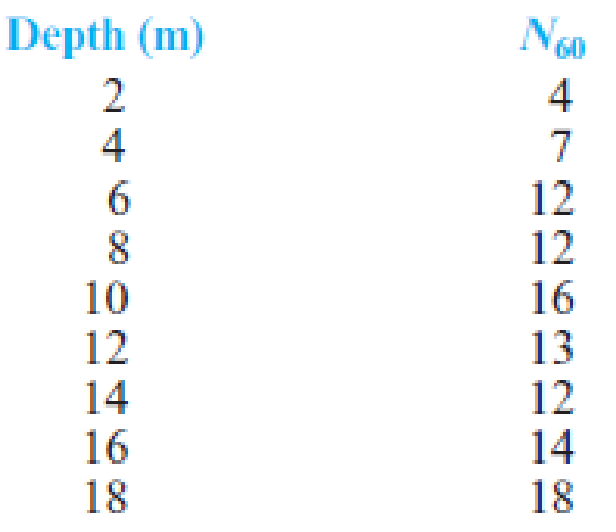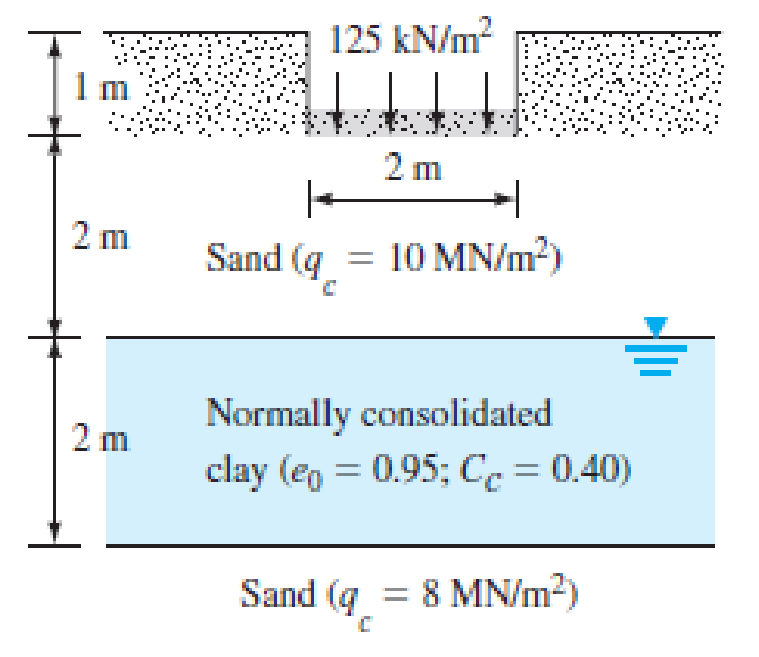
Fundamentals of Geotechnical Engineering (MindTap Course List)
5th Edition
ISBN: 9781305635180
Author: Braja M. Das, Nagaratnam Sivakugan
Publisher: Cengage Learning
expand_more
expand_more
format_list_bulleted
Concept explainers
Textbook Question
Chapter 17, Problem 17.15P
A shallow square foundation for a column is to be constructed. It must carry a net vertical load of 1000 kN. The soil supporting the foundation is sand. The standard penetration numbers (N60) obtained from field exploration are as follows:


FIG. 17.15
The groundwater table is located at a depth of 12 m. The unit weight of soil above the water table is 15.7 kN/m3, and the saturated unit weight of soil below the water table is 18.8 kN/m3. Assume that the depth of the foundation will be 1.5 m and the tolerable settlement is 25 mm. Determine the size of the foundation.
Expert Solution & Answer
Trending nowThis is a popular solution!

Students have asked these similar questions
A:
Wel
Question 2
(a) A simple circular hollow section (CHS) tubular K-joint in a steel structure, subjected to balanced
axial loading, is illustrated in Figure 2a. Determine the maximum hot spot stress at the joint
intersection of the chord and the loaded brace B.
(b) The steel structure is installed in the seawater with cathodic protection. Determine the number of
stress cycles to failure based on the maximum hot stress range obtained in part (a). Use the
NORSOK standard. (Refer to S-N curves for tubular joints in air environment and seawater with
cathodic protection).
(c) Estimate the number of load repetitions required to induce fatigue failure in the tubular joint, based
on the load history provided in Figure 2b. The nominal yield and ultimate tensile strength are 355
N/mm² and 510 N/mm², respectively. Assume a damage limit of 1.0. Use the Modified Goodman
formulation to determine the equivalent completely reversed stress.
(d) Describe briefly the procedure to determine the hot…
The steel member is a fillet welded built-up section that comprises two flange plates (100mm x 20mm) and a
web plate (250mm x 10mm) as depicted in Section A-A. The leg size of the weld is 8 mm. Use an
appropriate consequence class. Based on the damage tolerant method and the modified Goodman equation.
Determine an equivalent completely reversed stress. Ignore the vibration and dynamic amplification. Use
Euro-code 1993-1-9.
(a) Calculate the maximum and minimum stresses at steel member section A-A.
(b) Check the fatigue resistance of the steel member at Section A-A using the fatigue limit.
(c) Discuss the possible failure mode of the steel member due to fatigue loading.
State your design assumptions, if any.
Steel plate (Flange)
100mm x 20mm
10.0 m
Fillet weld (manual)
(Typical)
Steel plate (Web)
250mm x 10 mm
Steel plate (Flange)
100mm x 20mm
Section A-A
Fixed end
Welded built-up
steel section
5.0 m
A
2.5m
3.0 m
Fatigue load range 5 kN
A
Total weight of steel section
Total weight of…
30
20
10
Stress
N/mm² 0
-10
-20
-30
Time
Question 1
A Grade S355 steel member, which forms part of the structural framework supporting a storage tank in a
warehouse, is subjected to various loads, as shown in Figure 1. The yield and tensile strength of the steel
member are 355 N/mm² and 510 N/mm², respectively. The steel member is subjected to axial tension due to
its self-weight and appurtenances of 40.0kN. The 10.0kN storage tank is positioned 1.0 m from the
centreline of the steel member, and it experiences a fatigue load range of 5.0kN.
The steel member is a fillet welded built-up section that comprises two flange plates (100mm x 20mm) and a
web plate (250mm x 10mm) as depicted in Section A-A. The leg size of the weld is 8 mm. Use an
appropriate consequence class. Based on the damage tolerant method and the modified Goodman equation.
Determine an equivalent completely reversed stress. Ignore the vibration and dynamic amplification. Use
Euro-code 1993-1-9.
(a) Calculate the maximum…
Chapter 17 Solutions
Fundamentals of Geotechnical Engineering (MindTap Course List)
Knowledge Booster
Learn more about
Need a deep-dive on the concept behind this application? Look no further. Learn more about this topic, civil-engineering and related others by exploring similar questions and additional content below.Similar questions
- Please do not use design aid - R. Show step by step and every formular usedarrow_forwardFollowing is the variation of the field standard penetration number (№60) in a sand deposit: Depth (m) N60 1.5 6 3 8 4.5 9 6 8 7.5 9 13 14 The groundwater table is located at a depth of 6 m. Given: the dry unit weight of sand from 0 to a depth of 6 m is 16 kN/m³, and the saturated unit weight of sand for depth 6 to 12 m is 18.2 kN/m². Use the relationship given in the equation CN = 1 σo/Pa 0.5 to calculate the corrected penetration numbers. (Round your answers to the nearest whole number.) Depth (m) Neo (N1)00 1.5 3 6 8 4.5 9 6 7.5 9 14 8 13arrow_forward1,5 m 1,5 m A 1,6 KN F 0,8 m E 0,8 marrow_forward
- 5.85 The flow pattern through the pipe contraction is as shown, and the Q of water is 60 cfs. For d = 2 ft and D = 6 ft, what is the pressure at point B if the pressure at point C is 3200 psf? D E Problem 5.85 20° Barrow_forwardPlease solve problem 8.13 (the highlighted question).arrow_forwardThe following figure shows a vertical retaining wall with a granular backfill: 100.0 50.0 40.0 30.0 20.0 10.0- 5.0- 4.0 3.0- 2.0- = +1 0.8 0.6 0.4 0.2 0.0 -0.2 -0.4 -0.6 -0.8 -0.9 1.0- 0 10 20 30 40 45 ' (deg) (a) Figure Caquot and Kerisel's solution for K 3 Let H = 4m, a = 17.5°, y = 17.5 kN/m³, ' = 35°, and 8' = 10°. For given values of ' and 8', R' = 0.53. Based on Caquot and Kerisel's solution, what would be the passive force per meter length of the wall? (Enter your answer to two significant figures.) Pp= kN/marrow_forward
- The dam presented below is 180 m long (in the direction perpendicular to the plane of thecross-section). For the water elevations given on the drawing:a) Construct the flow net (minimum number of equipotential lines should be 10),b) Calculate the rate of seepage for the entire dam,c) Find the total uplift force on the dam (ignore barriers), andd) Estimate the hydraulic gradient at points A, B, and Darrow_forwardThe influence line for moment at B for the beam shown is A -6 m- B a. O at A, 6 at B, and 15 at C b. 1 at A, 1 at B, and 1 at C c. O at A, 0 at B, and -9 at C d. O at A, 1 at B, and 1 and C -9 m-arrow_forwardConsider the following figure: H/3 Pa Given: H = 7 m, y = 13 kN/m³, ø′ = 25°, c′ = 12 kN/m², and a = 10°. For given values, K₁ = 0.296. Calculate the Rankine active force per unit length of the wall after the occurrence of the tensile crack. (Enter your answer to three significant figures.) Pa = kN/marrow_forward
- Wall movement to left 45+ '/2 45 + 6'/2 Rotation of wall about this point A vertical retaining wall shown in the figure above is 7 m high with a horizontal backfill. For the backfill, assume that y = 14.5 kN/m³, ' = 26°, and c′ = 18 kN/m². Determine the Rankine active force per unit length of the wall after the occurrence of the tensile crack. (Enter your answer to three significant figures.) Pa = kN/marrow_forwardConsider the following figure: 0.6 "d 0.5 k₁ = 0 0.4 03 =0 kh = 0.2 0.3 0.025 0.2 0.05 0.1 0.1 0.2 0 -0.1 ↓ 0 5 10 15 20 25 30 35 40 45 ' (deg) For a retaining wall with a vertical back and horizontal backfill with a c'-' soil, the following are given: H = 10 ft Y = 111 lb/ft³ ' = 25° kh = 0.2 k₁ = 0 c = 113 lb/ft² Determine the magnitude of active force Pae on the wall. (Enter your answer to two significant figures.) Pae = lb/ftarrow_forwardA 13.0 ft high vertical wall retains an overconsolidated soil where OCR = 1.5, c' = 0, and ' magnitude and the location of the horizontal load on the wall, assuming the at-rest condition. Use Ysat (Enter your answers to three significant figures.) 33°. If the entire soil behind the wall is submerged with the water level at the ground surface, determine the 127 lb/ft³. Activity Frame P₁ = lb/ft Height above the bottom of the wall = O Icon Kov ftarrow_forward
arrow_back_ios
SEE MORE QUESTIONS
arrow_forward_ios
Recommended textbooks for you
 Fundamentals of Geotechnical Engineering (MindTap...Civil EngineeringISBN:9781305635180Author:Braja M. Das, Nagaratnam SivakuganPublisher:Cengage Learning
Fundamentals of Geotechnical Engineering (MindTap...Civil EngineeringISBN:9781305635180Author:Braja M. Das, Nagaratnam SivakuganPublisher:Cengage Learning Principles of Foundation Engineering (MindTap Cou...Civil EngineeringISBN:9781337705028Author:Braja M. Das, Nagaratnam SivakuganPublisher:Cengage Learning
Principles of Foundation Engineering (MindTap Cou...Civil EngineeringISBN:9781337705028Author:Braja M. Das, Nagaratnam SivakuganPublisher:Cengage Learning Principles of Foundation Engineering (MindTap Cou...Civil EngineeringISBN:9781305081550Author:Braja M. DasPublisher:Cengage Learning
Principles of Foundation Engineering (MindTap Cou...Civil EngineeringISBN:9781305081550Author:Braja M. DasPublisher:Cengage Learning Principles of Geotechnical Engineering (MindTap C...Civil EngineeringISBN:9781305970939Author:Braja M. Das, Khaled SobhanPublisher:Cengage Learning
Principles of Geotechnical Engineering (MindTap C...Civil EngineeringISBN:9781305970939Author:Braja M. Das, Khaled SobhanPublisher:Cengage Learning

Fundamentals of Geotechnical Engineering (MindTap...
Civil Engineering
ISBN:9781305635180
Author:Braja M. Das, Nagaratnam Sivakugan
Publisher:Cengage Learning

Principles of Foundation Engineering (MindTap Cou...
Civil Engineering
ISBN:9781337705028
Author:Braja M. Das, Nagaratnam Sivakugan
Publisher:Cengage Learning

Principles of Foundation Engineering (MindTap Cou...
Civil Engineering
ISBN:9781305081550
Author:Braja M. Das
Publisher:Cengage Learning

Principles of Geotechnical Engineering (MindTap C...
Civil Engineering
ISBN:9781305970939
Author:Braja M. Das, Khaled Sobhan
Publisher:Cengage Learning
Types of Foundation in building construction in detail - Civil Engineering Videos; Author: Civil Engineers;https://www.youtube.com/watch?v=7sl4KuM4UIE;License: Standard YouTube License, CC-BY
Types of Foundation || Foundation Engineering; Author: Civil Engineering;https://www.youtube.com/watch?v=AFLuAKGhanw;License: Standard Youtube License